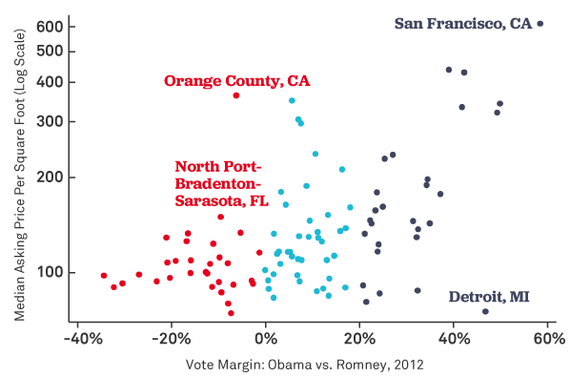The Atlantic discusses a new report from Trulia, suggesting that liberal cities have much worse housing crises than similarly-sized conservative cities.
The line isn’t smooth—and there are exceptions—but the relationship is clear: In general, richer cities have less affordable housing.
But there’s a second reason why San Francisco’s problem is emblematic of a national story. Liberal cities seem to have the worst affordability crises, according to Trulia chief economist Jed Kolko.
In a recent article, Kolko divided the largest cities into 32 “red” metros where Romney got more votes than Obama in 2012 (e.g. Houston [JB: I think they must mean Houston metro area, as Harris County went blue, but if you lump in surrounding areas it would be advantage for Romney], 40 “light-blue” markets where Obama won by fewer than 20 points (e.g. Austin), and 28 “dark-blue” metros where Obama won by more than 20 points (e.g. L.A., SF, NYC). Although all three housing groups faced similar declines in the recession and similar bounce-backs in the recovery, affordability remains a bigger problem in the bluest cities.
“Even after adjusting for differences of income, liberal markets tend to have higher income inequality and worse affordability,” Kolko said.
This graph shows how comparably sized red cities have significantly lower housing prices than their counterpart blue cities.
As a libertarian property scholar–something of an anomaly–I am often frustrated when I try to convey that the liberal policies that make a city look nicer, and stop construction, have a significant deleterious effect on the affordability of housing. And these are the same cities that go to great lengths to make housing more affordable through government programs, when government programs are responsible for making the housing unaffordable on the market.
The Atlantic continues:
Kolko’s theory isn’t an outlier. There is a deep literature tying liberal residents to illiberal housing policies that create affordability crunches for the middle class. In 2010, UCLA economist Matthew Kahn published a study of California cities, which found that liberal metros issued fewer new housing permits. The correlation held over time: As California cities became more liberal, he said, they built fewer homes.
“All homeowners have an incentive to stop new housing,” Kahn told me, “because if developers build too many homes, prices fall, and housing is many families’ main asset. But in cities with many Democrats and Green Party members, environmental concerns might also be a factor. The movement might be too eager to preserve the past.”
When the goal of a zoning system is to avoid any change that may lower housing prices, it is entirely unsurprising that housing prices go up. The cases that find preserving housing values as part of the general welfare seems out of whack, as it harms the general population, except for the people who are already living in an area.
